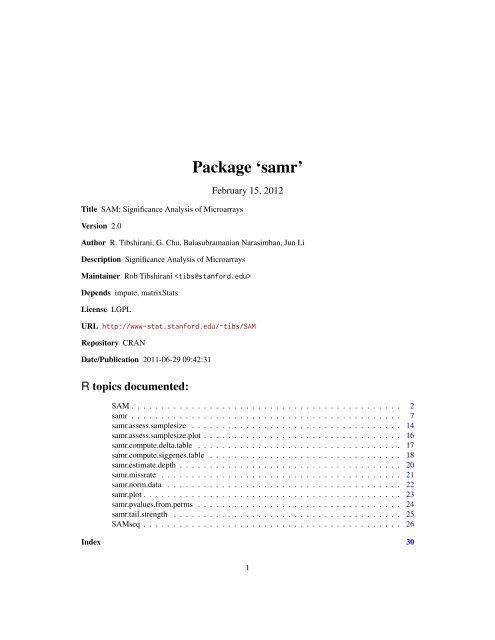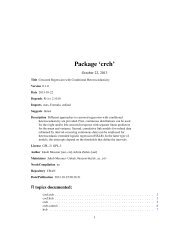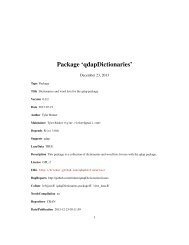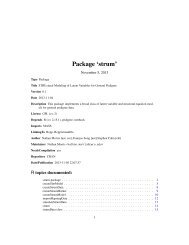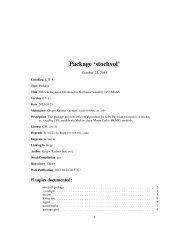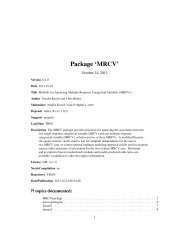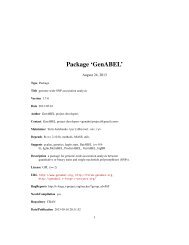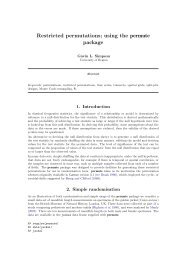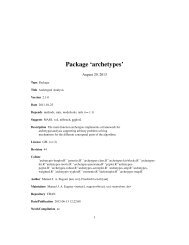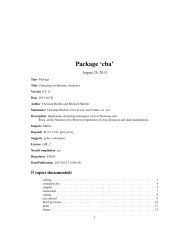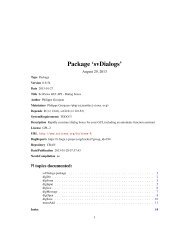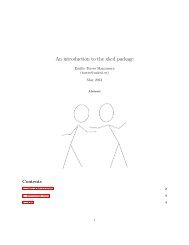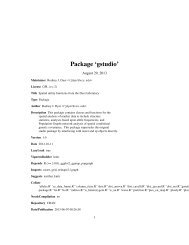Package 'samr'
Package 'samr'
Package 'samr'
You also want an ePaper? Increase the reach of your titles
YUMPU automatically turns print PDFs into web optimized ePapers that Google loves.
Title SAM: Significance Analysis of Microarrays<br />
Version 2.0<br />
<strong>Package</strong> ‘samr’<br />
February 15, 2012<br />
Author R. Tibshirani, G. Chu, Balasubramanian Narasimhan, Jun Li<br />
Description Significance Analysis of Microarrays<br />
Maintainer Rob Tibshirani <br />
Depends impute, matrixStats<br />
License LGPL<br />
URL http://www-stat.stanford.edu/~tibs/SAM<br />
Repository CRAN<br />
Date/Publication 2011-06-29 09:42:31<br />
R topics documented:<br />
SAM . . . . . . . . . . . . . . . . . . . . . . . . . . . . . . . . . . . . . . . . . . . . . 2<br />
samr . . . . . . . . . . . . . . . . . . . . . . . . . . . . . . . . . . . . . . . . . . . . . 7<br />
samr.assess.samplesize . . . . . . . . . . . . . . . . . . . . . . . . . . . . . . . . . . . 14<br />
samr.assess.samplesize.plot . . . . . . . . . . . . . . . . . . . . . . . . . . . . . . . . . 16<br />
samr.compute.delta.table . . . . . . . . . . . . . . . . . . . . . . . . . . . . . . . . . . 17<br />
samr.compute.siggenes.table . . . . . . . . . . . . . . . . . . . . . . . . . . . . . . . . 18<br />
samr.estimate.depth . . . . . . . . . . . . . . . . . . . . . . . . . . . . . . . . . . . . . 20<br />
samr.missrate . . . . . . . . . . . . . . . . . . . . . . . . . . . . . . . . . . . . . . . . 21<br />
samr.norm.data . . . . . . . . . . . . . . . . . . . . . . . . . . . . . . . . . . . . . . . 22<br />
samr.plot . . . . . . . . . . . . . . . . . . . . . . . . . . . . . . . . . . . . . . . . . . . 23<br />
samr.pvalues.from.perms . . . . . . . . . . . . . . . . . . . . . . . . . . . . . . . . . . 24<br />
samr.tail.strength . . . . . . . . . . . . . . . . . . . . . . . . . . . . . . . . . . . . . . 25<br />
SAMseq . . . . . . . . . . . . . . . . . . . . . . . . . . . . . . . . . . . . . . . . . . . 26<br />
Index 30<br />
1
2 SAM<br />
SAM Significance analysis of microarrays - simple user interface<br />
Description<br />
Usage<br />
Correlates a large number of features (eg genes) with an outcome variable, such as a group indicator,<br />
quantitative variable or survival time. This is a simple user interface for the samr function applied<br />
to array data. For sequencing data applications, see the function SAMseq.<br />
SAM(x,y=NULL,censoring.status=NULL,<br />
resp.type=c("Quantitative","Two class unpaired","Survival","Multiclass",<br />
"One class", "Two class paired","Two class unpaired timecourse",<br />
"One class timecourse","Two class paired timecourse", "Pattern discovery"),<br />
geneid = NULL,<br />
genenames = NULL,<br />
s0=NULL,<br />
s0.perc=NULL,<br />
nperms=100,<br />
center.arrays=FALSE,<br />
testStatistic=c("standard","wilcoxon"),<br />
time.summary.type=c("slope","signed.area"),<br />
regression.method=c("standard","ranks"),<br />
return.x=TRUE,<br />
knn.neighbors=10,<br />
random.seed=NULL,<br />
logged2 = FALSE,<br />
fdr.output = 0.20,<br />
eigengene.number = 1)<br />
Arguments<br />
x Feature matrix: p (number of features) by n (number of samples), one observation<br />
per column (missing values allowed)<br />
y n-vector of outcome measurements<br />
censoring.status<br />
n-vector of censoring censoring.status (1= died or event occurred, 0=survived,<br />
or event was censored), needed for a censored survival outcome<br />
resp.type Problem type: "Quantitative" for a continuous parameter; "Two class unpaired";<br />
"Survival" for censored survival outcome; "Multiclass": more than 2 groups;<br />
"One class" for a single group; "Two class paired" for two classes with paired<br />
observations; "Two class unpaired timecourse", "One class time course", "Two<br />
class.paired timecourse", "Pattern discovery"<br />
geneid Optional character vector of geneids for output.<br />
genenames Optional character vector of genenames for output.
SAM 3<br />
Details<br />
Value<br />
s0 Exchangeability factor for denominator of test statistic; Default is automatic<br />
choice. Only used for array data.<br />
s0.perc Percentile of standard deviation values to use for s0; default is automatic choice;<br />
-1 means s0=0 (different from s0.perc=0, meaning s0=zeroeth percentile of standard<br />
deviation values= min of sd values. Only used for array data.<br />
nperms Number of permutations used to estimate false discovery rates<br />
center.arrays Should the data for each sample (array) be median centered at the outset? Default<br />
=FALSE. Only used for array data.,<br />
testStatistic Test statistic to use in two class unpaired case.Either "standard" (t-statistic) or<br />
,"wilcoxon" (Two-sample wilcoxon or Mann-Whitney test). Only used for array<br />
data.<br />
time.summary.type<br />
Summary measure for each time course: "slope", or "signed.area"). Only used<br />
for array data.<br />
regression.method<br />
Regression method for quantitative case: "standard", (linear least squares) or<br />
"ranks" (linear least squares on ranked data). Only used for array data.<br />
return.x Should the matrix of feature values be returned? Only useful for time course<br />
data, where x contains summaries of the features over time. Otherwise x is the<br />
same as the input data data\$x<br />
knn.neighbors Number of nearest neighbors to use for imputation of missing features values.<br />
Only used for array data.<br />
random.seed Optional initial seed for random number generator (integer)<br />
logged2 Has the data been transformed by log (base 2)? This information is used only<br />
for computing fold changes<br />
fdr.output (Approximate) False Discovery Rate cutoff for output in significant genes table<br />
eigengene.number<br />
Eigengene to be used (just for resp.type="Pattern discovery")<br />
This is a simple, user-friendly interface to the samr package used on array data. It calls samr,<br />
samr.compute.delta.table and samr.compute.siggenes.table. samr detects differential expression for<br />
microarray data, and sequencing data, and other data with a large number of features. samr is the R<br />
package that is called by the "official" SAM Excel Addin. The format of the response vector y and<br />
the calling sequence is illustrated in the examples below. A more complete description is given in<br />
the SAM manual at http://www-stat.stanford.edu/~tibs/SAM<br />
A list with components<br />
samr.obj Output of samr. See documentation for samr for details.<br />
siggenes.table Table of significant genes, output of samr.compute.siggenes.table. This has<br />
components: genes.up— matrix of significant genes having positive correlation<br />
with the outcome and genes.lo—matrix of significant genes having negative<br />
correlation with the outcome. For survival data, genes.up are those genes
4 SAM<br />
having positive correlation with risk- that is, increased expression corresponds<br />
to higher risk (shorter survival) genes.lo are those whose increased expression<br />
corresponds to lower risk (longer survival).<br />
delta.table Output of samr.compute.delta.table.<br />
del Value of delta (distance from 45 degree line in SAM plot) for used for creating<br />
delta.table and siggenes.table. Changing the input value fdr.output will change<br />
the resulting del.<br />
call The calling sequence<br />
Author(s)<br />
Jun Li and Balasubrimanian Narasimhan and Robert Tibshirani<br />
References<br />
Tusher, V., Tibshirani, R. and Chu, G. (2001): Significance analysis of microarrays applied to the<br />
ionizing radiation response PNAS 2001 98: 5116-5121, (Apr 24). http://www-stat.stanford.edu/~tibs/SAM<br />
Li, Jun and Tibshirani, R. (2011). Finding consistent patterns: a nonparametric approach for identifying<br />
differential expression in RNA-Seq data. To appear, Statistical Methods in Medical Research.<br />
Examples<br />
######### two class unpaired comparison<br />
# y must take values 1,2<br />
set.seed(100)<br />
x
SAM 5<br />
u
6 SAM<br />
a
samr 7<br />
a
8 samr<br />
Details<br />
Value<br />
s0 Exchangeability factor for denominator of test statistic; Default is automatic<br />
choice. Only used for array data.<br />
s0.perc Percentile of standard deviation values to use for s0; default is automatic choice;<br />
-1 means s0=0 (different from s0.perc=0, meaning s0=zeroeth percentile of standard<br />
deviation values= min of sd values. Only used for array data.<br />
nperms Number of permutations used to estimate false discovery rates<br />
center.arrays Should the data for each sample (array) be median centered at the outset? Default<br />
=FALSE. Only used for array data.,<br />
testStatistic Test statistic to use in two class unpaired case.Either "standard" (t-statistic) or<br />
,"wilcoxon" (Two-sample wilcoxon or Mann-Whitney test). Only used for array<br />
data.<br />
time.summary.type<br />
Summary measure for each time course: "slope", or "signed.area"). Only used<br />
for array data.<br />
regression.method<br />
Regression method for quantitative case: "standard", (linear least squares) or<br />
"ranks" (linear least squares on ranked data). Only used for array data.<br />
return.x Should the matrix of feature values be returned? Only useful for time course<br />
data, where x contains summaries of the features over time. Otherwise x is the<br />
same as the input data data\$x<br />
knn.neighbors Number of nearest neighbors to use for imputation of missing features values.<br />
Only used for array data.<br />
random.seed Optional initial seed for random number generator (integer)<br />
nresamp For assay.type="seq", number of resamples used to construct test statistic. Default<br />
20. Only used for sequencing data.<br />
nresamp.perm For assay.type="seq", number of resamples used to construct test statistic for<br />
permutations. Default is equal to nresamp and it must be at most nresamp. Only<br />
used for sequencing data.<br />
xl.mode Used by Excel interface<br />
xl.time Used by Excel interface<br />
xl.prevfit Used by Excel interface<br />
Carries out a SAM analysis. Applicable to microarray data, sequencing data, and other data<br />
with a large number of features. This is the R package that is called by the "official" SAM Excel<br />
package v2.0. The format of the response vector y and the calling sequence is illustrated in<br />
the examples below. A more complete description is given in the SAM manual at http://wwwstat.stanford.edu/~tibs/SAM<br />
A list with components<br />
n Number of observations
samr 9<br />
x Data matrix p by n (p=\# genes or features). Equal to the matrix data\$x in<br />
the original call to samr except for (1) time course analysis, where is contains<br />
the summarized data or (2) quantitative outcome with rank regression, where it<br />
contains the data transformed to ranks. Hence it is null except for in time course<br />
analysis.<br />
y Vector of n outcome values. equal the values data\$y in the original call to<br />
samr, except for (1) time course analysis, where is contains the summarized y<br />
or (2) quantitative outcome with rank regression, where it contains the y values<br />
transformed to ranks<br />
argy The values data\$y in the original call to samr<br />
censoring.status<br />
Censoring status indicators if applicable<br />
testStatistic Test Statistic used<br />
,<br />
nperms Number of permutations requested<br />
nperms.act Number of permutations actually used. Will be < nperms when \# of possible<br />
permutations
10 samr<br />
censoring.status.star.keep<br />
n by nperms.act matrix of censoring.status indicators from each permutation<br />
resp.type The response type used. Same as resp.type.arg, except for time course data,<br />
where time data is summarized and then treated as non-time course. Eg if<br />
resp.type.arg="oneclass.timecourse" then resp.type="oneclass"<br />
resp.type.arg The response type requested in the call to samr<br />
stand.contrasts<br />
For multiclass data, p by nclass matrix of standardized differences between the<br />
class mean and the overall mean<br />
stand.contrasts.star<br />
For multiclass data, p by nclass by nperms.act array of standardized contrasts<br />
for permuted datasets<br />
stand.contrasts.95<br />
For multiclass data, 2.5 of standardized contrasts. Useful for determining which<br />
class contrast for significant genes, are large<br />
depth For array.type="seq", estimated sequencing depth for each sample.<br />
call calling sequence<br />
Author(s)<br />
Jun Li and Balasubrimanian Narasimhan and Robert Tibshirani<br />
References<br />
Tusher, V., Tibshirani, R. and Chu, G. (2001): Significance analysis of microarrays applied to the<br />
ionizing radiation response PNAS 2001 98: 5116-5121, (Apr 24). http://www-stat.stanford.edu/~tibs/SAM<br />
Li, Jun and Tibshirani, R. (2011). Finding consistent patterns: a nonparametric approach for identifying<br />
differential expression in RNA-Seq data. To appear, Statistical Methods in Medical Research.<br />
Examples<br />
######### two class unpaired comparison<br />
# y must take values 1,2<br />
set.seed(100)<br />
x
samr 11<br />
delta=.4<br />
samr.plot(samr.obj,delta)<br />
delta.table
12 samr<br />
# y must take numeric values<br />
set.seed(84048)<br />
x=matrix(rnorm(1000*9),ncol=9)<br />
mu=c(3,2,1,0,0,0,1,2,3)<br />
b=runif(100)+.5<br />
x[1:100,]=x[1:100,]+ b<br />
y=mu<br />
d=list(x=x,y=y,<br />
geneid=as.character(1:nrow(x)),genenames=paste("gene", as.character(1:nrow(x))))<br />
samr.obj =samr(d, resp.type="Quantitative", nperms=50)<br />
########### oneclass<br />
# y is a vector of ones<br />
set.seed(100)<br />
x
samr 13<br />
################multi-class example<br />
# y takes values 1,2,3,...k where k= number of classes<br />
set.seed(84048)<br />
x=matrix(rnorm(1000*10),ncol=10)<br />
x[1:50,6:10]= x[1:50,6:10]+2<br />
x[51:100,6:10]= x[51:100,6:10]-2<br />
y=c(rep(1,3),rep(2,3),rep(3,4))<br />
d=list(x=x,y=y,geneid=as.character(1:1000),<br />
genenames=paste("gene", as.character(1:1000)))<br />
samr.obj
14 samr.assess.samplesize<br />
# here there is no outcome y; the desired eigengene is indicated by<br />
# the argument eigengene.numbe in the data object<br />
set.seed(32)<br />
x=matrix(rnorm(1000*9),ncol=9)<br />
mu=c(3,2,1,0,0,0,1,2,3)<br />
b=3*runif(100)+.5<br />
x[1:100,]=x[1:100,]+ b<br />
d=list(x=x,eigengene.number=1,<br />
geneid=as.character(1:nrow(x)),genenames=paste("gene", as.character(1:nrow(x))))<br />
samr.obj=samr(d, resp.type="Pattern discovery", nperms=50)<br />
samr.assess.samplesize<br />
Assess the sample size for a SAM analysis<br />
Description<br />
Usage<br />
Estimate the false discovery rate, false negative rate, power and type I error for a SAM analysis.<br />
Currently implemented only for two class (unpaired or paired), one-sample and survival problems).<br />
samr.assess.samplesize(samr.obj, data, dif, samplesize.factors=c(1,2,3,5),<br />
min.genes = 10, max.genes = nrow(data$x)/2)<br />
Arguments<br />
samr.obj Object returned from call to samr<br />
data Data list, same as that passed to samr.train<br />
dif Change in gene expression between groups 1 and 2, for genes that are differentially<br />
expressed. For log base 2 data, a value of 1 means a 2-fold change. For<br />
One-sample problems, dif is the number of units away from zero for differentially<br />
expressed genes. For survival data, dif is the numerator of the Cox score<br />
statistic (this info is provided in the output of samr).<br />
samplesize.factors<br />
Integer vector of length 4, indicating the sample sizes to be examined. The<br />
values are factors that multiply the original sample size. So the value 1 means a<br />
sample size of ncol(data$x), 2 means a sample size of ncol(data$x), etc.<br />
min.genes Minimum number of genes that are assumed to truly changed in the population<br />
max.genes Maximum number of genes that are assumed to truly changed in the population
samr.assess.samplesize 15<br />
Details<br />
Value<br />
Estimates false discovery rate, false negative rate, power and type I error for a SAM analysis. The<br />
argument samplesize.factor allows the use to assess the effect of varying the sample size (total<br />
number of samples). A detailed description of this calculation is given in the SAM manual at<br />
http://www-stat.stanford.edu/~tibs/SAM<br />
A list with components<br />
Results A matrix with columns: number of genes- both the number differentially expressed<br />
genes in the population and number called significant; cutpoint- the<br />
threshold used for the absolute SAM score d; FDR, 1-power- the median false<br />
discovery rate, also equal to the power for each gene; FDR-90perc- the upper<br />
90th percentile of the FDR; FNR, Type 1 error- the false negative rate, also equal<br />
to the type I error for each gene; FNR-90perc- the upper 90th percentile of the<br />
FNR<br />
dif.call Change in gene expression between groups 1 and 2, that was provided in the call<br />
to samr.assess.samplesize<br />
difm The average difference in SAM score d for the genes differentially expressed vs<br />
unexpressed<br />
samplesize.factor<br />
The samplesize.factor that was passed to samr.assess.samplesiz<br />
n Number of samples in input data (i.e. ncol of x component in data)<br />
Author(s)<br />
Jun Li and Balasubrimanian Narasimhan and Robert Tibshirani<br />
References<br />
Tusher, V., Tibshirani, R. and Chu, G. (2001): Significance analysis of microarrays applied to the<br />
ionizing radiation response" PNAS 2001 98: 5116-5121, (Apr 24). http://www-stat.stanford.edu/~tibs/sam<br />
Taylor, J., Tibshirani, R. and Efron. B. (2005). The “Miss rate” for the analysis of gene expression<br />
data. Biostatistics 2005 6(1):111-117.<br />
A more complete description is given in the SAM manual at http://www-stat.stanford.edu/~tibs/SAM<br />
Examples<br />
#generate some example data<br />
set.seed(100)<br />
x
16 samr.assess.samplesize.plot<br />
data=list(x=x,y=y, geneid=as.character(1:nrow(x)),<br />
genenames=paste("g",as.character(1:nrow(x)),sep=""), logged2=TRUE)<br />
log2=function(x){log(x)/log(2)}<br />
# run SAM first<br />
samr.obj
samr.compute.delta.table 17<br />
References<br />
Tusher, V., Tibshirani, R. and Chu, G. (2001): Significance analysis of microarrays applied to the<br />
ionizing radiation response" PNAS 2001 98: 5116-5121, (Apr 24). http://www-stat.stanford.edu/~tibs/sam<br />
Examples<br />
#generate some example data<br />
set.seed(100)<br />
x
18 samr.compute.siggenes.table<br />
Details<br />
dels vector of delta values used. Delta is the vertical distance from the 45 degree<br />
line to the upper and lower parallel lines that define the SAM threshold rule. By<br />
default, for array data, 50 values are chosen in the relevant operating change for<br />
delta. For sequencing data, the maximum number of effective delta values are<br />
chosen automatically according to the data.<br />
nvals Number of delta values used. For array data, the default value is 50. For sequencing<br />
data, the value will be chosen automatically.<br />
Returns a table of the FDR and upper and lower cutpoints for various values of delta, for a SAM<br />
analysis.<br />
Author(s)<br />
Balasubrimanian Narasimhan and Robert Tibshirani<br />
References<br />
Tusher, V., Tibshirani, R. and Chu, G. (2001): Significance analysis of microarrays applied to the<br />
ionizing radiation response" PNAS 2001 98: 5116-5121, (Apr 24). http://www-stat.stanford.edu/~tibs/sam<br />
Examples<br />
#generate some example data<br />
set.seed(100)<br />
x
samr.compute.siggenes.table 19<br />
Description<br />
Usage<br />
Computes significant genes table, starting with samr object "samr.obj" and delta.table "delta.table"<br />
samr.compute.siggenes.table(samr.obj, del, data, delta.table,<br />
min.foldchange=0, all.genes=FALSE, compute.localfdr=FALSE)<br />
Arguments<br />
Value<br />
samr.obj Object returned from call to samr<br />
del Value of delta to define cutoff rule<br />
data Data object, same as that used in call to samr<br />
delta.table Object returned from call to samr.compute.delta.table<br />
min.foldchange The minimum fold change desired; should be >1; default is zero, meaning no<br />
fold change criterion is applied<br />
all.genes Should all genes be listed? Default FALSE<br />
compute.localfdr<br />
Should the local fdrs be computed (this can take some time)? Default FALSE<br />
return(list(genes.up=res.up, genes.lo=res.lo, color.ind.for.multi=color.ind.for.multi, ngenes.up=ngenes.up,<br />
ngenes.lo=ngenes.lo))<br />
genes.up Matrix of significant genes having posative correlation with the outcome. For<br />
survival data, genes.up are those genes having positive correlation with risk- that<br />
is, increased expression corresponds to higher risk (shorter survival).<br />
genes.lo Matrix of significant genes having negative correlation with the outcome. For<br />
survival data,genes. lo are those whose increased expression corresponds to<br />
lower risk (longer survival).<br />
color.ind.for.multi<br />
For multiclass response: a matrix with entries +1 if the class mean is larger than<br />
the overall mean at the 95 levels, -1 if less, and zero otehrwise. This is useful in<br />
determining which class or classes causes a feature to be significant<br />
ngenes.up Number of significant genes with positive correlation<br />
ngenes.lo Number of significant genes with negative correlation<br />
Author(s)<br />
Balasubrimanian Narasimhan and Robert Tibshirani<br />
References<br />
Tusher, V., Tibshirani, R. and Chu, G. (2001): Significance analysis of microarrays applied to the<br />
ionizing radiation response" PNAS 2001 98: 5116-5121, (Apr 24). http://www-stat.stanford.edu/~tibs/sam
20 samr.estimate.depth<br />
Examples<br />
#generate some example data<br />
set.seed(100)<br />
x
samr.missrate 21<br />
Author(s)<br />
Jun Li and Balasubrimanian Narasimhan and Robert Tibshirani<br />
References<br />
Tusher, V., Tibshirani, R. and Chu, G. (2001): Significance analysis of microarrays applied to the<br />
ionizing radiation response PNAS 2001 98: 5116-5121, (Apr 24). http://www-stat.stanford.edu/~tibs/SAM<br />
Examples<br />
set.seed(100)<br />
mu
22 samr.norm.data<br />
Examples<br />
#generate some example data<br />
set.seed(100)<br />
x
samr.plot 23<br />
Value<br />
x the normalized data matrix.<br />
Author(s)<br />
Jun Li and Balasubrimanian Narasimhan and Robert Tibshirani<br />
References<br />
Tusher, V., Tibshirani, R. and Chu, G. (2001): Significance analysis of microarrays applied to the<br />
ionizing radiation response PNAS 2001 98: 5116-5121, (Apr 24). http://www-stat.stanford.edu/~tibs/SAM<br />
Examples<br />
set.seed(100)<br />
mu
24 samr.pvalues.from.perms<br />
Author(s)<br />
Jun Li and Balasubrimanian Narasimhan and Robert Tibshirani<br />
References<br />
Tusher, V., Tibshirani, R. and Chu, G. (2001): Significance analysis of microarrays applied to the<br />
ionizing radiation response" PNAS 2001 98: 5116-5121, (Apr 24). http://www-stat.stanford.edu/~tibs/sam<br />
Examples<br />
#generate some example data<br />
set.seed(100)<br />
x
samr.tail.strength 25<br />
Author(s)<br />
Jun Li and Balasubrimanian Narasimhan and Robert Tibshirani<br />
References<br />
Taylor, J. and Tibshirani, R. (2005): A tail strength measure for assessing the overall significance<br />
in a dataset. Submitted.<br />
Examples<br />
#generate some example data<br />
set.seed(100)<br />
x
26 SAMseq<br />
Author(s)<br />
Jun Li and Balasubrimanian Narasimhan and Robert Tibshirani<br />
References<br />
Taylor, J. and Tibshirani, R. (2005): A tail strength measure for assessing the overall significance<br />
in a dataset. Submitted.<br />
Examples<br />
#generate some example data<br />
set.seed(100)<br />
x
SAMseq 27<br />
Arguments<br />
Details<br />
Value<br />
x Feature matrix: p (number of features) by n (number of samples), one observation<br />
per column (missing values allowed)<br />
y n-vector of outcome measurements<br />
censoring.status<br />
n-vector of censoring censoring.status (1=died or event occurred, 0=survived, or<br />
event was censored), needed for a censored survival outcome<br />
resp.type Problem type: "Quantitative" for a continuous parameter; "Two class unpaired"<br />
for two classes with unpaired observations; "Survival" for censored survival outcome;<br />
"Multiclass": more than 2 groups; "Two class paired" for two classes with<br />
paired observations.<br />
geneid Optional character vector of geneids for output.<br />
genenames Optional character vector of genenames for output.<br />
nperms Number of permutations used to estimate false discovery rates<br />
random.seed Optional initial seed for random number generator (integer)<br />
nresamp Number of resamples used to construct test statistic. Default 20.<br />
fdr.output (Approximate) False Discovery Rate cutoff for output in significant genes table<br />
This is a simple, user-friendly interface to the samr package used on sequencing data. It automatically<br />
disables arguments/features that do not apply to sequencing data. It calls samr, samr.compute.delta.table<br />
and samr.compute.siggenes.table. samr detects differential expression for microarray data, and sequencing<br />
data, and other data with a large number of features. samr is the R package that is called<br />
by the "official" SAM Excel Addin. The format of the response vector y and the calling sequence<br />
is illustrated in the examples below. A more complete description is given in the SAM manual at<br />
http://www-stat.stanford.edu/~tibs/SAM<br />
A list with components<br />
samr.obj Output of samr. See documentation for samr for details<br />
siggenes.table Table of significant genes, output of samr.compute.siggenes.table. This has<br />
components: genes.up—matrix of significant genes having positive correlation<br />
with the outcome and genes.lo—matrix of significant genes having negative correlation<br />
with the outcome. For survival data, genes.up are those genes having<br />
positive correlation with risk- that is, increased expression corresponds to<br />
higher risk (shorter survival) genes.lo are those whose increased expression corresponds<br />
to lower risk (longer survival).<br />
delta.table Output of samr.compute.delta.table.<br />
del Value of delta (distance from 45 degree line in SAM plot) for used for creating<br />
delta.table and siggenes.table. Changing the input value fdr.output will change<br />
the resulting del.<br />
call The calling sequence
28 SAMseq<br />
Author(s)<br />
Jun Li and Balasubrimanian Narasimhan and Robert Tibshirani<br />
References<br />
Tusher, V., Tibshirani, R. and Chu, G. (2001): Significance analysis of microarrays applied to the<br />
ionizing radiation response PNAS 2001 98: 5116-5121, (Apr 24). http://www-stat.stanford.edu/~tibs/SAM<br />
Li, Jun and Tibshirani, R. (2011). Finding consistent patterns: a nonparametric approach for identifying<br />
differential expression in RNA-Seq data. To appear, Statistical Methods in Medical Research.<br />
Examples<br />
######### two class unpaired comparison<br />
set.seed(100)<br />
mu
SAMseq 29<br />
mu[71:100, 16:20]
Index<br />
∗Topic nonparametric<br />
SAM, 2<br />
samr, 7<br />
samr.assess.samplesize, 14<br />
samr.assess.samplesize.plot, 16<br />
samr.compute.delta.table, 17<br />
samr.compute.siggenes.table, 18<br />
samr.missrate, 21<br />
samr.plot, 23<br />
samr.pvalues.from.perms, 24<br />
samr.tail.strength, 25<br />
SAMseq, 26<br />
∗Topic survival<br />
SAM, 2<br />
samr, 7<br />
samr.assess.samplesize, 14<br />
samr.assess.samplesize.plot, 16<br />
samr.compute.delta.table, 17<br />
samr.compute.siggenes.table, 18<br />
samr.missrate, 21<br />
samr.plot, 23<br />
samr.pvalues.from.perms, 24<br />
samr.tail.strength, 25<br />
SAMseq, 26<br />
∗Topic ts<br />
SAM, 2<br />
samr, 7<br />
samr.assess.samplesize, 14<br />
samr.assess.samplesize.plot, 16<br />
samr.compute.delta.table, 17<br />
samr.compute.siggenes.table, 18<br />
samr.missrate, 21<br />
samr.plot, 23<br />
SAMseq, 26<br />
∗Topic univar<br />
SAM, 2<br />
samr, 7<br />
samr.assess.samplesize, 14<br />
samr.assess.samplesize.plot, 16<br />
30<br />
samr.compute.delta.table, 17<br />
samr.compute.siggenes.table, 18<br />
samr.estimate.depth, 20<br />
samr.missrate, 21<br />
samr.norm.data, 22<br />
samr.plot, 23<br />
samr.pvalues.from.perms, 24<br />
samr.tail.strength, 25<br />
SAMseq, 26<br />
SAM, 2<br />
samr, 7<br />
samr.assess.samplesize, 14<br />
samr.assess.samplesize.plot, 16<br />
samr.compute.delta.table, 17<br />
samr.compute.siggenes.table, 18<br />
samr.estimate.depth, 20<br />
samr.missrate, 21<br />
samr.norm.data, 22<br />
samr.plot, 23<br />
samr.pvalues.from.perms, 24<br />
samr.tail.strength, 25<br />
SAMseq, 26


